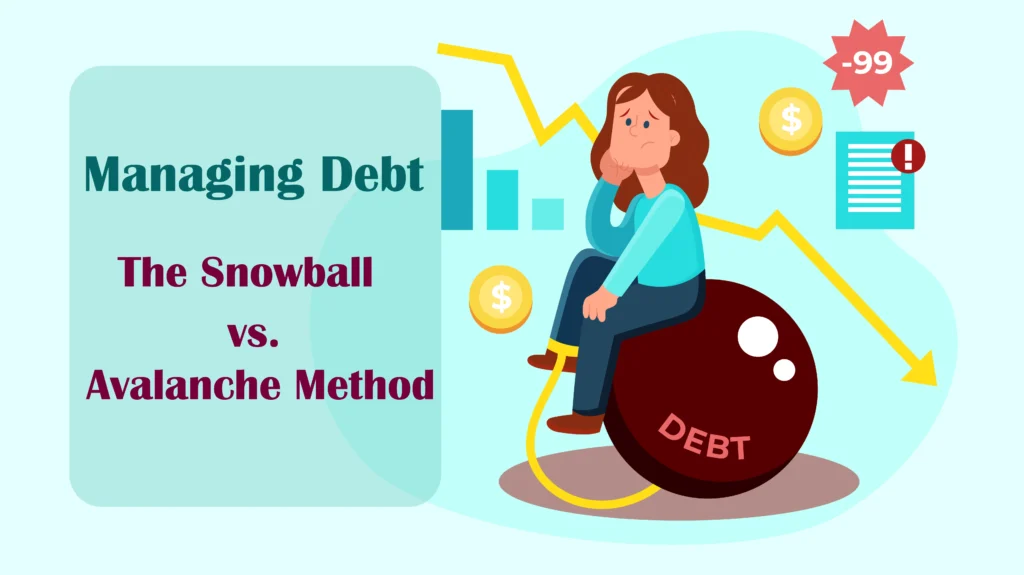How to Manage Debt as a Small Business Owner
Managing debt as a small business owner can feel like walking a tightrope—one misstep, and you could find yourself teetering on the edge of financial instability. With the pressure to maintain cash flow, invest in growth, and cover operational expenses, the burden of debt can quickly become overwhelming. Many entrepreneurs face the harsh reality of needing loans or credit to kickstart their ventures, but as their businesses grow, so does the need for effective debt management strategies. Understanding how to balance borrowing with repayment is crucial for long-term success and sustainability.
In this blog post, we’ll explore practical tips to help you manage debt as a small business owner. From assessing your current financial situation to creating a realistic repayment plan, we’ll provide actionable strategies that can ease your financial burden. By maintaining healthy cash flow and exploring alternative financing options, you’ll be better equipped to navigate your debt challenges and keep your business thriving.

Understanding Small Business Debt
Debt is an essential part of business financing, enabling business owners to invest in growth, cover operating expenses, or purchase necessary equipment. However, not all debt is created equal, and understanding the different types of debt is critical to managing it effectively. Small business owners often deal with various types of debt, each with its own terms, interest rates, and risks.
Types of Business Debt
Small businesses typically face a mix of debt, ranging from traditional loans to lines of credit. Knowing what type of debt your business holds will help you prioritize payments and manage cash flow effectively.
Business Loans
Business loans are one of the most common forms of debt for small businesses. These loans, which include traditional term loans and Small Business Administration (SBA) loans, are used for various purposes, such as financing the purchase of equipment, expanding operations, or managing cash flow. Term loans often come with fixed monthly payments and set interest rates, making them predictable, but they can also carry high-interest rates depending on your creditworthiness and the lender.
Credit Lines and Business Credit Cards
Business credit lines and credit cards are revolving forms of credit, meaning you can borrow, repay, and borrow again as needed. While they offer flexibility and immediate access to capital, the interest rates on business credit cards and lines of credit are often higher than term loans, especially if you only make the minimum payment each month. Mismanaging this type of debt can quickly lead to a high credit utilization ratio, which can harm your credit profile and increase your debt burden.
Supplier and Vendor Financing
Supplier and vendor financing involves receiving goods or services on credit from your suppliers, with the agreement to pay later. This type of financing can be beneficial for managing cash flow, but it’s essential to keep up with payments to maintain good relationships with vendors and avoid interest charges or penalties.
Invoice Financing
Invoice financing allows businesses to borrow money against unpaid invoices. This is particularly useful for businesses with long payment cycles. While it can provide immediate cash flow relief, it also adds to your debt, and the fees can be high. If your clients delay payments further, you could end up owing more in fees and interest.
Evaluating Your Current Debt Situation
The first step to managing your business debt is to understand your current financial situation fully. This means reviewing your debts, assessing their terms, and identifying which debts are putting the most strain on your business. Proper evaluation allows you to create a plan for paying off debt strategically while maintaining enough cash flow to keep the business running smoothly.
Reviewing Your Balance Sheet
Your business’s balance sheet is one of the most critical tools for evaluating your debt situation. It provides a snapshot of your assets, liabilities, and equity, allowing you to see exactly how much you owe and to whom.
Understanding Liabilities and Equity
Liabilities are your business’s financial obligations, including both short-term and long-term debts. Short-term liabilities typically include accounts payable and any debt due within a year, while long-term liabilities include loans or mortgages payable over a longer period. Your equity represents the owner’s investment in the business after all debts have been paid. Regularly reviewing your liabilities and equity will help you track your business’s financial health.
Debt-to-Equity Ratio
One key metric to evaluate is your debt-to-equity ratio, which compares your total liabilities to your total equity. This ratio shows how much of your business is financed by debt versus the owner’s investment. A high debt-to-equity ratio indicates that your business is heavily reliant on borrowed money, which can be risky, especially if cash flow fluctuates. Ideally, businesses should aim for a balanced ratio, ensuring they aren’t overleveraged.
Identifying High-Interest and Risky Debts
Not all debt carries the same risk or cost. Some debts, particularly those with high-interest rates, can quickly become unmanageable if not addressed. Identifying and prioritizing these debts is essential to creating an effective debt repayment strategy.
Assessing Interest Rates and Terms
The first step is to review the interest rates on each of your debts. High-interest loans or credit cards can eat into your cash flow and make it difficult to reduce your principal balance. Paying off these high-interest debts first can save your business money in the long term. Additionally, consider the terms of each loan. Short-term loans with large payments due soon may require immediate attention, while long-term loans with manageable payments can take a lower priority.
Short-Term vs. Long-Term Debt
Short-term debts are typically due within a year, while long-term debts are spread over several years. Short-term debt often carries higher interest rates and can pose a greater risk to your cash flow if not managed carefully. Prioritizing short-term debt, especially if it has high interest, can relieve immediate financial pressure and free up cash flow for other uses.
Creating a Debt Management Strategy
Once you’ve evaluated your current debt situation, it’s time to develop a strategic plan for managing and paying off your debt. This plan should focus on reducing high-interest debt, maintaining regular payments, and optimizing your cash flow to meet both your business and debt obligations.
Prioritizing Debt Repayment
One of the most effective ways to manage business debt is by prioritizing repayment based on the cost and risk each debt presents. This requires a structured approach to ensure you’re making the best use of your available cash.
Focusing on High-Interest Debt First
Paying down high-interest debt first can significantly reduce the total amount of interest you pay over time. This method, often called the “debt avalanche” approach, targets the most expensive debts, helping you save money in the long run. While it might take longer to see the total number of debts decrease, this method ensures that you pay off the most costly debts first.
Maintaining Minimum Payments on Other Debts
While focusing on high-interest debts, it’s crucial to continue making the minimum payments on your other debts. Missing payments on any loan or credit line can damage your business’s credit score and may lead to penalties or higher interest rates. By keeping up with minimum payments, you can protect your credit and prevent additional debt from accumulating.
Refinancing and Debt Consolidation Options
If you’re struggling with multiple high-interest debts, refinancing or consolidating your debt could be a good option. These strategies can help lower your monthly payments or reduce the total interest paid over time.
Benefits of Refinancing
Refinancing involves replacing one or more of your current loans with a new loan, ideally with better terms such as a lower interest rate or longer repayment period. By securing a lower interest rate, you can reduce your monthly payments and free up cash flow, allowing you to focus on growing your business.
Debt Consolidation Loans
Debt consolidation involves combining multiple debts into one loan, which can simplify your repayment process. Instead of juggling several payments, you’ll make one payment each month. If you secure a lower interest rate through consolidation, this can also reduce your overall debt burden. However, it’s important to carefully review the terms of any consolidation loan to ensure it doesn’t extend your repayment period too long, which could increase the total interest you pay.
≫ Related Post: 9 Proven Debt Consolidation Strategies
Budgeting for Debt Repayment
Effective debt management requires careful budgeting. You need to ensure that you have enough cash flow to cover both your operating expenses and your debt payments. This may require adjusting your business’s budget to prioritize debt repayment.
Reevaluating Cash Flow
Start by reviewing your business’s cash flow to see where adjustments can be made. Are there areas where you can increase revenue or reduce expenses? Improving cash flow will make it easier to pay down your debt faster and reduce your reliance on borrowing in the future.
Cutting Unnecessary Expenses
One of the easiest ways to free up cash for debt repayment is by cutting unnecessary expenses. Review your business’s budget and identify areas where you can reduce costs. Whether it’s eliminating non-essential services or renegotiating supplier contracts, trimming expenses can provide extra cash for debt payments.
Using Debt to Drive Growth (Responsibly)
While reducing debt is a priority, it’s important to recognize that debt isn’t always a bad thing. When managed responsibly, debt can be a powerful tool to help you grow your business. The key is to ensure that any new debt you take on is used strategically and generates a return that exceeds its cost.
Strategic Investment with Debt
Using debt to invest in growth opportunities, such as expanding your operations, upgrading equipment, or hiring new employees, can help your business generate more revenue. However, it’s essential to have a clear plan for how these investments will pay off and to avoid overextending your business financially.
Investing in High-Return Opportunities
Before taking on new debt, evaluate the potential return on investment (ROI) of any new project or purchase. Focus on opportunities that will generate revenue quickly and pay for themselves over time. For example, purchasing new equipment that allows you to increase production or expand your product line could result in higher sales and profits, making the debt worthwhile.
Balancing Debt and Growth
While debt can drive growth, it’s essential to maintain a balance between leveraging debt for growth and ensuring that your cash flow remains strong. Avoid taking on more debt than your business can comfortably manage, even if the investment seems promising.
Debt as a Tax Deduction
One benefit of business debt is that the interest you pay on loans and credit lines may be tax-deductible. This can help reduce your taxable income and improve your cash flow, making debt management more affordable.
Understanding Business Interest Deductions
The IRS allows businesses to deduct interest paid on business loans, including lines of credit, equipment financing, and credit card debt. Be sure to keep detailed records of your interest payments and consult with a tax professional to ensure you’re taking full advantage of these deductions.
Negotiating with Creditors and Lenders
If your business is struggling to keep up with debt payments, it’s important to communicate with your creditors and lenders early. Many lenders are willing to work with you to renegotiate payment terms or offer temporary relief, especially if you’re proactive about seeking help.
Contacting Creditors Early
If you’re at risk of missing a payment, contact your creditors before the payment is due. Explain your situation and ask if they can offer any relief, such as extending the payment deadline or temporarily reducing your payments. Creditors are more likely to work with you if you reach out before you default on the debt.
Requesting Lower Interest Rates
In some cases, you may be able to negotiate a lower interest rate on your loans or credit lines. This can reduce your monthly payments and make it easier to manage your debt. If you have a good payment history and a strong relationship with your lender, don’t hesitate to ask for a lower rate.
Restructuring Payment Terms
If your business’s cash flow is temporarily strained, you may be able to restructure your debt repayment terms. This could involve extending the loan term, reducing the monthly payment amount, or even pausing payments for a short period. However, it’s essential to understand the long-term implications of any restructuring, as it may increase the total amount of interest you pay over time.
Avoiding Debt Traps and Risky Debt Practices
While debt can be a valuable tool for business growth, it’s important to avoid common debt traps that can lead to financial problems. Mismanaging debt or relying too heavily on credit can quickly spiral out of control.
Relying Too Heavily on Credit
Many small business owners fall into the trap of relying too heavily on credit to cover operating expenses or cash flow gaps. While credit can provide short-term relief, overusing it can lead to high-interest payments and increased debt levels, which can become unmanageable.
Managing Revolving Credit Carefully
If your business uses revolving credit, such as a credit line or credit cards, be sure to manage it carefully. Pay off your balances as quickly as possible and avoid carrying large amounts of debt from month to month. This will reduce the amount of interest you pay and prevent your credit utilization ratio from hurting your credit score.
Taking on Debt Without a Clear Plan
Taking on new debt without a clear plan for how it will be repaid can lead to financial trouble. Before borrowing, ensure that you have a realistic repayment plan in place and that the new debt will contribute to your business’s growth.
Evaluating the ROI of Any New Debt
Before taking on additional debt, carefully evaluate the potential return on investment. Will the new debt help your business grow, increase profits, or improve efficiency? If the answer is no, it may be better to avoid taking on more debt.
Tools and Resources for Managing Small Business Debt
Managing small business debt can be challenging, but there are plenty of tools and resources available to help you stay organized and on top of your payments.
Financial Software for Tracking Debt
Using financial software like QuickBooks or Xero can help you track your business’s debt, payments, and cash flow. These tools can also help you monitor upcoming due dates and manage your budget more effectively.
Using Cash Flow Forecasting Tools
Cash flow forecasting tools can help you anticipate and plan for upcoming debt payments. By projecting your future cash flow, you can identify potential shortfalls and make adjustments to ensure you have enough cash on hand to cover your expenses and debt payments.
Working with Financial Advisors
If managing your business’s debt feels overwhelming, consider working with a financial advisor or accountant. A financial advisor can help you create a debt management plan, evaluate your financial health, and suggest strategies for improving cash flow.
Seeking Debt Counseling for Small Businesses
If your business is struggling with significant debt, a professional debt counselor can help you negotiate with creditors, create a repayment plan, and avoid bankruptcy. Debt counseling can provide a clear path forward for businesses facing financial difficulties.
Conclusion
Managing debt as a small business owner requires a thoughtful and strategic approach. By understanding your current debt situation, prioritizing repayments, and exploring options like refinancing or debt consolidation, you can take control of your finances and reduce the burden of debt. Additionally, leveraging debt responsibly for business growth and avoiding common debt traps can help you build a stronger, more financially stable business in the long term. Stay proactive, monitor your cash flow carefully, and don’t hesitate to seek professional guidance when needed.
















